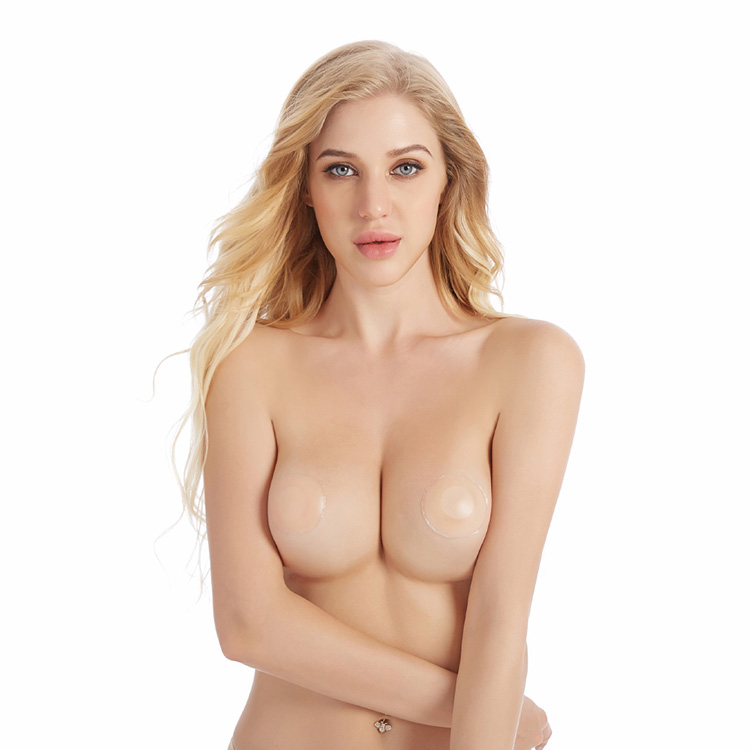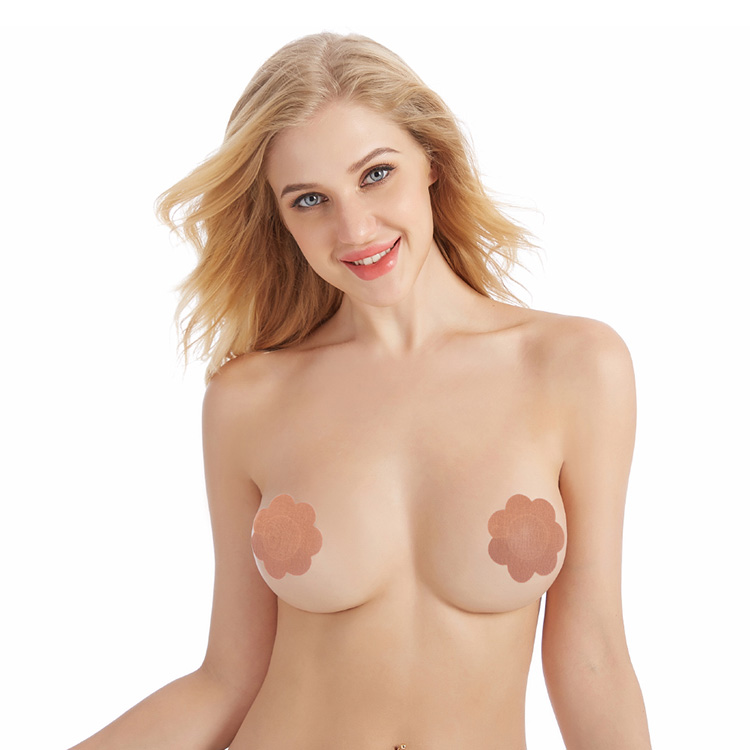نواجه جميعًا تلك اللحظات التي تحتاج فيها خزانة ملابسنا أو بشرتنا إلى القليل من العناية الإضافية. على سبيل المثال, قد يكون التعامل مع تهيج الحلمة أو تجنب الرؤية غير المرغوب فيها أمرًا صعبًا. إذا كنت تبحث عن حل سريع وعملي, قد يكون استخدام الضمادات كأغطية للحلمة هو ما تحتاجين إليه. يمكن لهذه الخدعة البسيطة أن توفر لك راحة وراحة فورية عندما تكون في أمس الحاجة إليها, تمتزج بسلاسة مع روتينك اليومي.

لماذا يضع الناس الضمادات على حلماتهم؟?
يلجأ الناس إلى الضمادات من أجل حلماتهم لأنها فعالة حقًا. أولا وقبل كل شيء, يمكن أن تعمل الضمادات كحاجز لمنع التهيج الناتج عن الملابس الخشنة أو الضيقة. وهذا مفيد بشكل خاص عند ارتداء الأقمشة التي قد تحتك أو تحتك بالبشرة الحساسة. بالإضافة إلى ذلك, يمكن أن توفر الضمادات حلاً سريًا لإخفاء الحلمات تحت الملابس الشفافة أو المناسبة للشكل, حيث التقليدية يغطي الحلمة قد تكون ضخمة جدًا أو مرئية.
في بعض الحالات, تُستخدم الضمادات أثناء الأنشطة البدنية أو التمارين الرياضية لمنع الاحتكاك والاحتكاك الذي يمكن أن يحدث مع الحركة المتكررة. طبيعتها اللاصقة تضمن بقائها في مكانها, توفير الحماية طوال النشاط. بالإضافة إلى, تعتبر الضمادات خيارًا سريعًا ويمكن الوصول إليه عندما لا تتوفر منتجات متخصصة أخرى, مما يجعلها خيارًا مناسبًا لأولئك الذين يبحثون عن راحة فورية أو إصلاح مؤقت.
كيفية استخدام الضمادات كأغطية للحلمة: دليل خطوة بخطوة

إذا قررت استخدام الضمادات كحل سريع لتغطية الحلمة, ومن المهم تطبيقها بشكل صحيح لضمان الراحة والفعالية. اتبع هذه الخطوات للتأكد من أن الضمادة الخاصة بك توفر الحماية التي تحتاجها مع الحفاظ على الأمان والراحة طوال اليوم.
خطوة 1: اختر الضمادة المناسبة
أول شيء أولا, يمكنك اختيار ضمادة أكبر من المساحة التي تريد تغطيتها. من الناحية المثالية, يمكنك أيضًا استخدام الضمادات الكبيرة جدًا أو الضخمة لضمان تغطية واسعة. اختر الخيارات المضادة للحساسية إذا كانت بشرتك حساسة لتقليل خطر التهيج. يرجى تجنب استخدام الصغيرة, الضمادات ذات الحجم العادي لأنها قد لا توفر الحماية أو التغطية الكافية.
خطوة 2: تحضير الجلد
قبل تطبيق الضمادة, نظفي منطقة الحلمة جيداً بالماء والصابون المعتدل. هذا يزيل العرق, زيوت, والأوساخ التي يمكن أن تؤثر على مادة لاصقة الضمادة. بعد الغسيل, جفف المنطقة بمنشفة ناعمة لضمان التصاق الضمادة بشكل صحيح. لا تستخدم المستحضرات أو الكريمات قبل وضع الضمادة, لأن هذه يمكن أن تضعف المادة اللاصقة.
خطوة 3: تطبيق الضمادة
ثم يمكنك تقشير الجزء الخلفي من الضمادة بعناية, تجنب لمس السطح اللاصق. قم بتوسيط الضمادة فوق الحلمة, مما يضمن أنها تمتد إلى ما وراء حواف الهالة للحصول على تغطية كاملة. قم بتنعيم الحواف للتخلص من التجاعيد وفقاعات الهواء, والتي يمكن أن تسبب عدم الراحة أو تقليل الفعالية. يجب ألا تكون الضمادة ضيقة جدًا أو فضفاضة جدًا, حيث يمكن أن يؤدي أي منهما إلى عدم الراحة أو التقشير.
خطوة 4: تحقق من الراحة والملاءمة
بعد تطبيق الضمادة, ارتديه لبضع دقائق للتأكد من أنه مريح ويبقى في مكانه. انتبه إلى أي علامات تهيج أو إزعاج. إذا شعرت بأي حكة أو حرقان, قم بإزالة الضمادة على الفور وفكر في تجربة علامة تجارية أو حجم مختلف.
خطوة 5: مراقبة واستبدال حسب الحاجة
يمكن تغيير الضمادة إذا لزم الأمر. قد تحتاج إلى استبدال الضمادة بشكل دوري بناءً على مستوى نشاطك ومدة ارتدائها. على سبيل المثال, إذا كنت تتعرق بشدة أو تمارس أنشطة شاقة, قد تفقد الضمادة خصائصها اللاصقة عاجلاً. قم بإزالة الضمادة بلطف لتجنب تهيج الجلد, واستبدالها بأخرى جديدة إذا لزم الأمر. يساعد الاستبدال المنتظم في الحفاظ على النظافة ويضمن الحماية المستمرة.
خطوة 6: إزالة وتنظيف المنطقة
عندما يحين وقت إزالة الضمادة, افعل ذلك ببطء وبلطف لمنع أي ضرر للجلد. إذا كان هناك أي مادة لاصقة متبقية على الجلد, استخدمي مزيل لاصق لطيف أو الماء الدافئ والصابون لتنظيفه. قم بتجفيف المنطقة بالتربيت عليها وتحقق من وجود أي علامات تهيج أو احمرار. إذا شعر الجلد بالتهيج, امنحها وقتًا للتعافي قبل وضع ضمادة أخرى.
هل من المقبول وضع الضمادات على ثقب الحلمة؟?
تطبيق الضمادات على ثقب الحلمة يتطلب دراسة متأنية. بينما يمكن أن توفر الضمادات تغطية مؤقتة, فهي ليست دائمًا مثالية للمناطق المثقوبة. قد تسبب المادة اللاصقة الموجودة على الضمادات تهيجًا أو تفاعلات حساسية, وخاصة على الحساسة, شفاء الجلد. بالإضافة إلى ذلك, يمكن للضمادات أن تحبس الرطوبة والبكتيريا, مما قد يؤدي إلى الإصابة بالعدوى أو إطالة عملية الشفاء.
إذا كنت بحاجة لتغطية ثقب الحلمة, من الأفضل استخدام أنواع أو منتجات مضادة للحساسية مصممة خصيصًا للمناطق المثقوبة. عادة ما تكون هذه الخيارات مصنوعة من مواد أكثر لطفاً على الجلد وأقل احتمالاً للتسبب في مضاعفات. بجانب, يمكنك دائمًا مراقبة أي علامات تهيج, واستشيري متخصصًا إذا كانت لديك مخاوف بشأن صحة ثقبك.
بدائل لتجنب احتكاك الحلمة والحلمات الدموية
إذا لم تكن الضمادات هي الحل المناسب لك, هناك العديد من البدائل التي يمكن أن تساعد في منع احتكاك الحلمة والحماية من التهيج. توفر هذه الخيارات درجات متفاوتة من الراحة والفعالية, حتى تتمكن من اختيار الأفضل لاحتياجاتك.
أغطية الحلمة من السيليكون

أغطية حلمة السيليكون هي بديل شائع بسبب مرونتها وراحتها. أنها توفر على نحو سلس, حاجز ناعم يقلل الاحتكاك ويمنع الاحتكاك. قابلة لإعادة الاستخدام وسهلة التنظيف, تتوافق هذه الأغطية مع شكل حلمتك, ضمان ملاءمة آمنة تحت الملابس.
ملصقات الحلمة القابل للتصرف

ملصقات الحلمة القابل للتصرف تعتبر خيارًا عمليًا وصحيًا لأولئك الذين يفضلون حل الاستخدام الواحد. تم تصميم هذه الملصقات لتوفير سلاسة, حاجز مريح ومثالي لتغطية الحلمات بشكل مخفي تحت الملابس. إنها تأتي بأحجام وأشكال مختلفة لتناسب الاحتياجات المختلفة وهي مفيدة بشكل خاص للاستخدام لمرة واحدة خلال المناسبات أو الأحداث الخاصة.
منصات القطن
للحصول على خيار أكثر ليونة, يمكن استخدام الفوط القطنية لإنشاء طبقة توسيد بين بشرتك وملابسك. وهي مفيدة بشكل خاص لامتصاص الرطوبة وتقليل الاحتكاك. ما عليك سوى وضع وسادة قطنية داخل حمالة الصدر أو المادة اللاصقة لتغطية منطقة الحلمة. اختر فوطًا ناعمة وقابلة للتنفس لتحقيق أقصى قدر من الراحة.
كريمات وبلسمات الحلمة
كريمات ومرطبات الحلمة مصممة خصيصًا لتهدئة وحماية البشرة. يمكن لهذه المنتجات أن تقلل الاحتكاك وتحافظ على ترطيب منطقة الحلمة, مما يساعد على منع الغضب والتهيج. ضعي طبقة رقيقة على منطقة الحلمة قبل ارتداء الملابس, واختيار منتج لطيف وخالي من المواد الكيميائية القاسية.
شريط رياضي متخصص
تم تصميم الشريط الرياضي ليتحمل النشاط القوي ويمكن أن يكون خيارًا فعالاً لمنع الاحتكاك أثناء التمرين. إنه يلتصق جيدًا ويوفر حاجزًا وقائيًا يبقى في مكانه حتى أثناء الحركة المكثفة. تأكد من استخدام شريط لاصق مناسب لملامسة الجلد ولا يسبب تهيجًا.
الملابس المناسبة
ارتداء الملابس المناسبة المصنوعة من المواد الناعمة, الأقمشة المسامية يمكن أن تقلل بشكل كبير من خطر احتكاك الحلمة. اختاري الملابس غير الضيقة وتجنبي الأقمشة التي قد تهيج بشرتك. يعتبر القطن والمواد الماصة للرطوبة خيارات مثالية للراحة والحماية.
نصائح إضافية لحماية حلماتك

لمزيد من حماية حلماتك من الانزعاج والتهيج, ضع في اعتبارك هذه النصائح الإضافية للحفاظ على صحتهم وراحتهم:
- اختر ناعم, أقمشة قابلة للتنفس: الملابس المصنوعة من الناعمة, يوصى باستخدام الألياف الطبيعية مثل القطن أو الخيزران. تسمح هذه المواد لبشرتك بالتنفس وتقليل احتمالية الاحتكاك. تجنب الأقمشة الاصطناعية التي يمكن أن تحبس الحرارة والرطوبة, يحتمل أن يؤدي إلى تهيج.
- ابق رطبًا ومرطبًا: يعد الحفاظ على رطوبة بشرتك أمرًا ضروريًا للحفاظ على مرونتها ومرونتها. يمكنك شرب الكثير من الماء واستخدام مرطب لطيف للحفاظ على نضارة بشرتك. هذا يمكن أن يساعد في منع الجفاف والتشقق, وهي الأسباب الشائعة لعدم الراحة في الحلمة.
- استثمر في حمالات الصدر عالية الجودة: يجب أن تتناسب حمالات الصدر بشكل صحيح وتوفر الدعم الكافي. تجنبي حمالات الصدر ذات الدرزات الخشنة أو العلامات المهيجة. ضعي في اعتبارك حمالات الصدر المصنوعة من مواد ناعمة, مواد قابلة للتمدد تتحرك مع جسمك وتقلل الاحتكاك.
- استخدمي واقيات الحلمة أثناء التمرين: أثناء الأنشطة البدنية أو الرياضة, استخدمي واقيات أو أغطية الحلمة المتخصصة المصممة لتحمل الحركة وتقليل الاحتكاك. يمكن أن تساعد هذه الواقيات في منع الاحتكاك والتهيج الناتج عن الحركة المتكررة.
- الحفاظ على النظافة الجيدة: اغسلي حلماتك بانتظام بالماء والصابون المعتدل لإزالة العرق والبكتيريا. تأكد من أن بشرتك جافة تمامًا قبل وضع أي أغطية أو ملابس واقية لتجنب تراكم الرطوبة, والتي يمكن أن تؤدي إلى تهيج.
- تجنب الحرارة المفرطة: انتبه للحرارة الزائدة والعرق, لأن هذه يمكن أن تؤدي إلى تفاقم تهيج الحلمة. إذا كنت في بيئة حارة, حاول أن تظل هادئًا وتغير ملابسك المتعرقة على الفور.
خاتمة
ضمان راحتك وإدارة مشكلات خزانة الملابس لا يجب أن يكون أمرًا صعبًا. من خلال تعلم كيفية استخدام الضمادات كأغطية للحلمة, يمكنك بسهولة معالجة التهيج ومنع التعرض غير المرغوب فيه. سواء لإصلاح سريع أو كجزء من روتينك اليومي, تقدم هذه الطريقة حلاً مباشرًا. مع النهج الصحيح والبدائل في متناول اليد, يمكنك الحفاظ على الراحة والثقة في أي موقف.
الأسئلة الشائعة
س1: هل يمكن أن تسبب الضمادات ردود فعل تحسسية على البشرة الحساسة?
نعم, يمكن أن تحتوي بعض الضمادات على مواد لاصقة قد تسبب تهيجًا أو حساسية, خاصة على البشرة الحساسة.
Q2: كم مرة يجب أن أغير الضمادة إذا كنت أستخدمها كغطاء للحلمة?
قم بتغيير الضمادة عندما تبدأ في التقشر أو بعد ارتدائها لفترة طويلة لضمان النظافة والراحة.
س3: هل هناك علامات تجارية محددة موصى بها للبشرة الحساسة؟?
ابحث عن خيارات البشرة الحساسة أو المضادة للحساسية من علامات تجارية مثل Nexcare أو Band-Aid.
س 4: كم من الوقت يجب ترك الضمادة على ثقب الحلمة?
يستغرق ثقب الحلمة حوالي 9-12 شهور للشفاء. قد يستغرق الأمر وقتًا أطول بالنسبة للبشرة الحساسة. في كل مرة تتركين ضمادة على الحلمة المثقوبة, تأكد من خلعه عندما تشعر بعدم الارتياح.
س5: هل يمكنني استخدام الشريط اللاصق العادي بدلاً من الضمادات لتغطية الحلمات؟?
قد لا يكون الشريط اللاصق العادي مناسبًا لأنه قد يكون أقل قابلية للتنفس وأكثر عرضة للتسبب في التهيج.
س6: ماذا علي أن أفعل إذا كانت الضمادة تسبب تهيجًا أو إزعاجًا؟?
قم بإزالة الضمادة على الفور, وإذا استمر التهيج, فكر في استخدام نوع مختلف من الغطاء أو استشر طبيب الأمراض الجلدية.